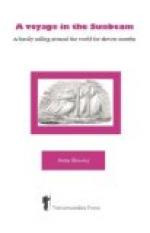Friday, February 9th.—We left by ten o’clock train for Osaka, which has been called the Venice of Japan. It is intersected by innumerable rivers and canals, and boats were continually making their appearance at points where they were least expected, as our jinrikisha men hurried us along the narrow and not very sweet-smelling streets. We went so fast that, more than once before we reached the Mint, I thought we should have been tipped into one of the canals, as we turned a sharp corner. Our men upset the baskets and stalls that encroached on the road, in the most unceremonious manner; but their proprietors did not seem to mind, many of them quietly moving their wares out of the way as they heard the shouts that announced our approach. The smell in the fish-market was disgusting, and enough to poison the air for miles around, but the people did not seem to mind it in the least.
At last we left the river and town, and, climbing a slight eminence, crossed the first moat by a stone bridge, and reached the guard-house on the other side. There was some hesitation at first about admitting us; but it was soon overcome. This castle, the last stronghold of the Tycoon, is built on exactly the same plan as the yashgis we had already visited, but much stronger, being composed of enormous blocks of stone. One wonders how human labour could ever have transported them from their quarry to this place, for some measured 40 ft. long by 20 ft. high. We crossed the three moats and the three enclosures, now all full of barracks and soldiers. In the very centre, the old well and a little square tower are still standing, part of the Tycoon’s original residence, which was destroyed by fire. The view from the top over the town and surrounding country is very fine. You can see countless streams coming from the mountains, and flowing into Odawarra, on which Osaka is situated. The course of the river itself could be traced to the bay; and the line of coast to Kobe, and the far-off mountains in the Inland Sea were plainly visible.
On returning to the Mint we found luncheon awaiting us, and afterwards spent a pleasant time looking at a wonderful collection of curios.
The Imperial Mint of Japan is a large handsome building, in great force just now, for the whole of the old money is being called in and replaced by the government. The contrast between the two moneys is very great. The ancient coinage consisted of long thin oval obangs and shobangs, worth from two dollars to eighteen pounds each, square silver itzeboos, and square copper pieces, with a hole in the centre; while that which is taking its place is similar to European coinage, and is marked in English characters, and ornamented with Japanese devices, such as the phoenix and the dragon. It did not seem worth while to go minutely over the Mint, as it is arranged on exactly the same principle as the one in London, and the processes are carried out in the same manner.




